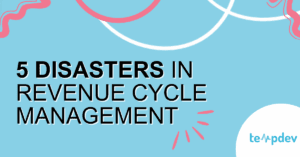Whenever I talk with experts in revenue cycle management, it’s amazing to hear them share how almost every hospital, health system, and medical practice has revenue cycle management (RCM) challenges. I heard one vendor call it revenue leakage which is an apt description for the situation at many healthcare organizations. In one respect, this means that your healthcare organization isn’t alone. In another, it means you have a great opportunity to address these RCM challenges and improve the bottom line for your organization.
 This is what came to mind when TempDev shared this detailed eBook they created called 5 Disasters in Revenue Cycle Management (RCM) and How to Avoid Them. Disasters may be overstating it for some organizations, but I guess any loss of revenue that your organization rightfully earned is a disaster.
This is what came to mind when TempDev shared this detailed eBook they created called 5 Disasters in Revenue Cycle Management (RCM) and How to Avoid Them. Disasters may be overstating it for some organizations, but I guess any loss of revenue that your organization rightfully earned is a disaster.
As I read through the eBook, two of the disasters really stood out for me. The first one that caught my eye was “Rising Denials and Claim Errors: Stop Draining Your Revenue.” This one was particularly important to me because I’ve seen it happen so often at organizations. I’d probably group this disaster into two types: the slow creep and ignorance is bliss.
The slow creep as I call it is those organizations who let their denials and claims errors just slowly deteriorate over time. They used to have few denials and errors, but over time that number just starts to creep up. Maybe you hired new staff who aren’t as good, maybe the doctors aren’t documenting as well as they did before, or your staff get distracted by another project and kind of set denials and claims to the side a bit. Plus, we all know that payers are doing their own slow creep as they deny more claims. And sometimes it’s a fast creep.
The ignorance is bliss crowd are those that just think that denials and errors are a normal part of doing business. They don’t realize that their denial and claims error rate could be better. They’re fine with the status quo and/or don’t realize that it could be better.
Of course, either of these situations is a disaster for an organization that needs that cash flow. If you check out TempDev’s RCM Disasters eBook, that section of the eBook offers a number of great strategies to address this disaster. Plus, they show how many of those denials are avoidable.
The other disaster that stood out to me was “Getting Paid: Mastering Patient Collections in Today’s Healthcare Landscape.” This is a topic we’ve covered a lot here on Healthcare IT Today, so regular readers will be familiar with it. For a long time, patient collections was kind of an after thought since the majority of cash flow was from payers. Now with high deductible plans and other changes, patients are shouldering a larger portion of the payment burden. That’s why mastering patient collections is so important and is a great opportunity for organizations to improve their revenue situation. I’m glad in the eBook they highlighted this problem and shared some ways to make patient collections a strength for your organization. It’s a great way to impact your bottom line.
Those are the 2 disasters that stood out to me. To see the other 3 disasters and to dive deeper into these 2 disasters and what you can do about them, be sure to go and download the FREE eBook by TempDev called 5 Disasters in Revenue Cycle Management (RCM) and How to Avoid Them.
Once you take a look at the 5 disasters they list, let us know on social media what you think of the list and what are some other RCM challenges that you would add to your list.
TempDev is a proud sponsor of Healthcare Scene.




